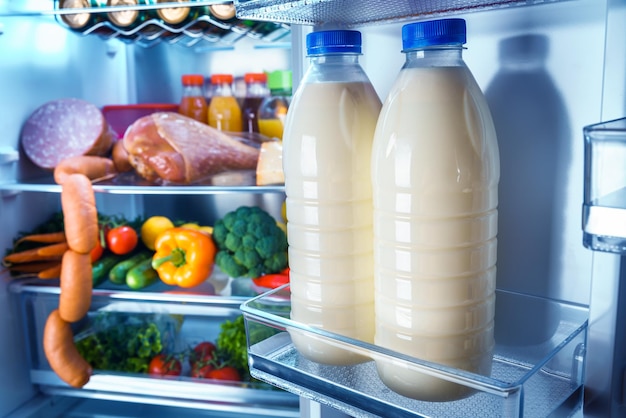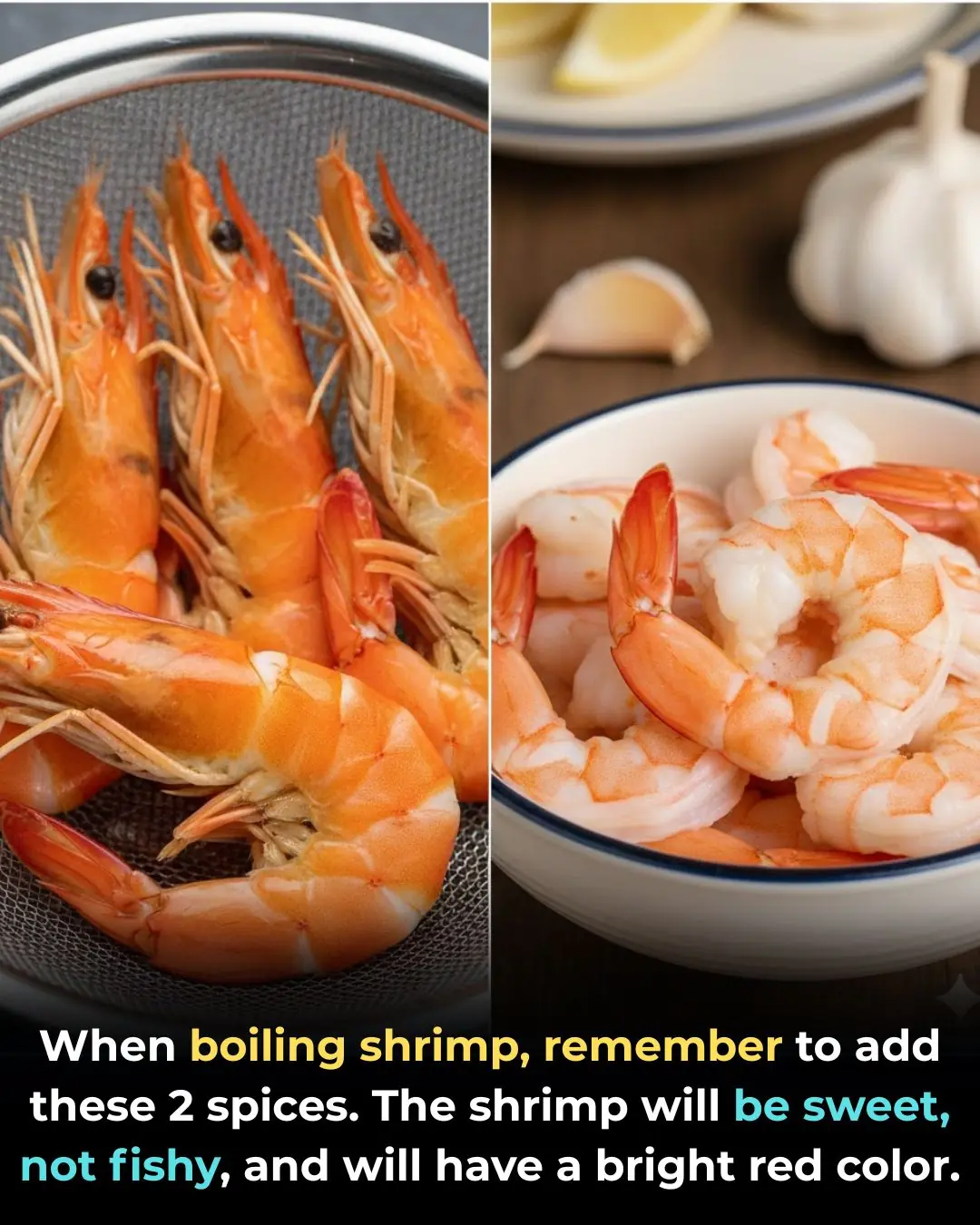
Never Store These 5 Foods in the Refrigerator Door — They Spoil Quickly and Can Increase the Risk of Food Poisoning
The refrigerator door is a convenient place for storing various items, thanks to its easy access. However, it is also the warmest and least stable area of the fridge because the temperature here fluctuates every time the door is opened. For certain foods, these changes can significantly speed up spoilage and even increase the risk of foodborne illness.
Below are 5 types of food you should never store in the refrigerator door, along with the reasons and safer alternatives.
1. Milk

Milk must be stored at a consistently cold temperature, ideally between 0–5°C (32–41°F). While the fridge door may occasionally reach this temperature, it cannot hold it steadily due to constant opening and closing.
Storing milk here causes it to warm up repeatedly, which accelerates bacterial growth. This leads to faster spoilage, curdling, sour odors, and potential digestive issues if consumed. If your milk tastes sour or looks discolored, discard it immediately.
Better option:
Store milk deep inside the refrigerator, preferably on the middle or bottom shelves where the temperature stays colder and more stable. Also, avoid placing milk near raw meat to reduce the risk of cross-contamination.
2. Eggs
Refrigeration helps extend the shelf life of eggs and reduces the risk of salmonella contamination. However, many people make the mistake of placing eggs in the built-in egg tray located on the refrigerator door. Although this spot seems designed for eggs, it’s actually the worst location for them.
Constant temperature swings in the door cause condensation to form on the egg shells. Moisture on the shell makes it easier for bacteria to penetrate the porous surface and contaminate the inside of the egg.
Furthermore, fluctuating temperatures can cause eggs to deteriorate more quickly, resulting in thinner whites and weaker yolks.
Better option:
Keep eggs in their original cardboard carton and store them on a stable, cold shelf, such as the bottom shelf or the vegetable drawer area. This helps maintain quality and reduces spoilage.
3. Raw Meat and Poultry

Raw meat, fish, and poultry must be kept as cold as possible—either in the freezer or at 4°C (40°F) or below. Storing them in the refrigerator door exposes them to temperature instability and increases the risk of bacterial growth.
Even worse, leaking juices from raw meat stored in the door can easily contaminate other foods, especially fruits and ready-to-eat items stored nearby.
Better option:
-
For long-term storage: keep meat in the freezer.
-
For short-term use (1–2 days): store raw meat on the bottom shelf, wrapped tightly or placed in a sealed container to prevent drips.
If raw meat has been left at room temperature for too long, cook it immediately and never return it to the fridge.
4. Pre-cut Fruits and Vegetables
Cut fruits and vegetables—especially melons, tomatoes, and leafy greens—are highly perishable. Once cut, the exposed surfaces become much more vulnerable to bacteria. The warmer, fluctuating conditions of the fridge door only speed up the spoilage.
High moisture levels in this area also encourage microbial growth, raising the risk of food poisoning if consumed.
Better option:
Store pre-cut produce in airtight containers and place them inside the main compartments of the fridge, where temperatures remain colder and more stable.
5. Leftovers
Leftovers can typically be stored safely in the refrigerator for 3–4 days, but only if kept below 4°C (40°F). Putting leftovers in the fridge door significantly shortens their safe storage time due to the unstable temperature.
Food stored here may spoil faster, develop off odors, or harbor harmful bacteria long before the usual 3–4 day window.
Better option:
Place leftovers in shallow, airtight containers and store them on the upper or middle shelves. If you don’t plan to eat them within a few days, freeze them to extend their shelf life.
What Can You Store in the Refrigerator Door Instead?
While these five foods are off-limits, the fridge door is still useful for items that are less sensitive to temperature changes, such as:
-
Condiments (ketchup, mustard, hot sauce)
-
Fruit juices and soft drinks
-
Pickles
-
Some types of dry packaged goods
These items can tolerate minor temperature fluctuations without spoiling quickly.
Additional Tips for Safe Food Storage in the Refrigerator
-
Clean the fridge regularly to remove spills, odors, and bacteria.
-
Maintain the fridge temperature at 4°C (40°F) or below.
-
Do not overcrowd the fridge—cold air needs space to circulate.
-
Label leftovers with dates to avoid forgetting them.
News in the same category


Why You Should Pour Boiling Water into the Hotel Toilet When Checking In

How to Distinguish Naturally Ripened Tomatoes from Chemically Ripened Ones: A Simple Tip

3 Types of Coffee That Can Boost Longevity and Protect Your Heart

Boiling Peanuts: Don’t Just Add Water – Add These 2 Ingredients for Soft, Delicious, and Long-Lasting Peanuts

Mixing Toothpaste with Menthol Balm: A Surprisingly Useful Household Hack

Something Everyone Throws Away but Is Surprisingly Useful — You’ll Regret Discarding It Once You Know Its Benefits

Why Do Rice Scoops Have Tiny Raised Dots on the Surface? The Real Purpose May Surprise You

Secret Tip: How to Clean Tile Floors and Make Them Shine, Without Spending a Dime

Tips to clean shiny enamel at home without spending a penny

How to help you travel thousands of miles without getting motion sickness

Making pickled garlic requires one more step

When boiling shrimp, remember to add these 2 spices. The shrimp will be sweet, not fishy, and will have a bright red color.

The rats will disappear after just 1 month with only 3 potatoes, so easy and very effective

Why are cucumbers bitter? Is it okay to eat bitter cucumbers?

How to make sesame and peanut sauce with just the right taste, keep it for a long time without getting too oily, eat it with cold rice is also delicious

Every family needs essential oil mixed with white vinegar. Everyone likes it because it is both safe and saves money.

How to grill soft and delicious skewers that are not dry, delicious but not boring, from a good mother

Cook braised meat without adding water: Add this to make the meat soft and flavorful without drying out.
News Post

Teen Inventor Creates Affordable Dialysis Machine, Revolutionizing Global Healthcare

PepsiCo Removes Petroleum-Based Dyes from Doritos, Paving the Way for Healthier Snacking

From Tragedy to Hope: How Compassion Saved a Life in Rural China

Meghan Trainor details health scare that inspired her weight loss journey, Mounjaro use

Why Tanker Trucks Have a Hanging Chain: Safety Function Explained

The Easiest Way to Clean a Glass Stove Top

Bill Belichick’s daughter-in-law exploded on Jordon Hudson in unhinged 40-minute postgame rant

🌿 The Quiet Power of Nature: Herbs That Support Balance, Energy, and Well-Being

8 Things Your Eyes Are Trying To Tell You About Your Health

A Toy Traffic Cone Found in a Man’s Lung After 40 Years: The Astonishing Medical Case That Was Mistaken for Lung Cancer

Jean Slater revealed as Zoe’s stalker… but fans aren’t buying it

Unlocking the secrets of clove water: a nighttime health elixir

Liquid NanoClay: The Norwegian Innovation Turning Deserts Into Fertile Farmland

Celia’s empire starts to crumble in Emmerdale as police raid Depot and Laurel grows suspicious

“Mind the Gap”: How a 20-Year-Old Medical Student Transformed Global Healthcare

I’m A Celebrity star Tom Read Wilson slammed by viewers over ‘annoying’ behaviour in camp

A look around Angry Ginge's former home shows I'm A Celeb star's 'true colours'

ITV Emmerdale's Lewis Barton 'set for new romance' as fans point out huge hint

Josie Gibson stuns as she shows off 5st weight loss in daring dress on cruise
